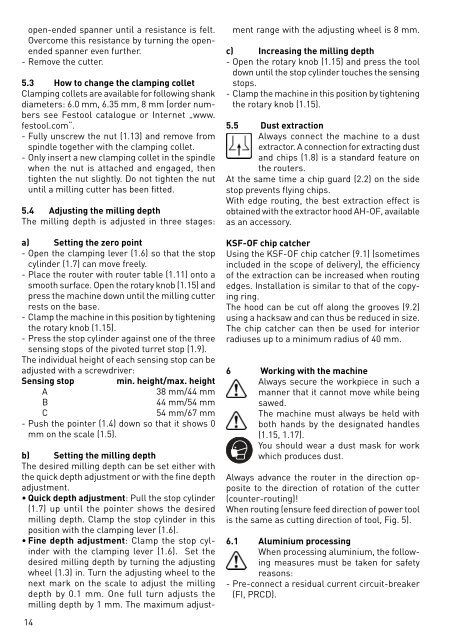Create successful ePaper yourself
Turn your PDF publications into a flip-book with our unique Google optimized e-Paper software.
open-ended spanner until a resistance is felt.<br />
Overcome this resistance by turning the openended<br />
spanner even further.<br />
- Remove the cutter.<br />
5.3 How to change the clamping collet<br />
Clamping collets are available for following shank<br />
diameters: 6.0 mm, 6.35 mm, 8 mm (order numbers<br />
see Festool catalogue or Internet „www.<br />
festool.com“.<br />
- Fully unscrew the nut (1.13) and remove from<br />
spindle together with the clamping collet.<br />
- Only insert a new clamping collet in the spindle<br />
when the nut is attached and engaged, then<br />
tighten the nut slightly. Do not tighten the nut<br />
until a milling cutter has been fi tted.<br />
5.4 Adjusting the milling depth<br />
The milling depth is adjusted in three stages:<br />
a) Setting the zero point<br />
- Open the clamping lever (1.6) so that the stop<br />
cylinder (1.7) can move freely.<br />
- Place the router with router table (1.11) onto a<br />
smooth surface. Open the rotary knob (1.15) and<br />
press the machine down until the milling cutter<br />
rests on the base.<br />
- Clamp the machine in this position by tightening<br />
the rotary knob (1.15).<br />
- Press the stop cylinder against one of the three<br />
sensing stops of the pivoted turret stop (1.9).<br />
The individual height of each sensing stop can be<br />
adjusted with a screwdriver:<br />
Sensing stop min. height/max. height<br />
A 38 mm/44 mm<br />
B 44 mm/54 mm<br />
C 54 mm/67 mm<br />
- Push the pointer (1.4) down so that it shows 0<br />
mm on the scale (1.5).<br />
b) Setting the milling depth<br />
The desired milling depth can be set either with<br />
the quick depth adjustment or with the fi ne depth<br />
adjustment.<br />
• Quick depth adjustment: Pull the stop cylinder<br />
(1.7) up until the pointer shows the desired<br />
milling depth. Clamp the stop cylinder in this<br />
position with the clamping lever (1.6).<br />
• Fine depth adjustment: Clamp the stop cylinder<br />
with the clamping lever (1.6). Set the<br />
desired milling depth by turning the adjusting<br />
wheel (1.3) in. Turn the adjusting wheel to the<br />
next mark on the scale to adjust the milling<br />
depth by 0.1 mm. One full turn adjusts the<br />
milling depth by 1 mm. The maximum adjust-<br />
14<br />
ment range with the adjusting wheel is 8 mm.<br />
c) Increasing the milling depth<br />
- Open the rotary knob (1.15) and press the tool<br />
down until the stop cylinder touches the sensing<br />
stops.<br />
- Clamp the machine in this position by tightening<br />
the rotary knob (1.15).<br />
5.5 Dust extraction<br />
Always connect the machine to a dust<br />
extractor. A connection for extracting dust<br />
and chips (1.8) is a standard feature on<br />
the routers.<br />
At the same time a chip guard (2.2) on the side<br />
stop prevents fl ying chips.<br />
With edge routing, the best extraction effect is<br />
obtained with the extractor hood AH-<strong>OF</strong>, available<br />
as an accessory.<br />
KSF-<strong>OF</strong> chip catcher<br />
Using the KSF-<strong>OF</strong> chip catcher (9.1) (sometimes<br />
included in the scope of delivery), the effi ciency<br />
of the extraction can be increased when routing<br />
edges. Installation is similar to that of the copying<br />
ring.<br />
The hood can be cut off along the grooves (9.2)<br />
using a hacksaw and can thus be reduced in size.<br />
The chip catcher can then be used for interior<br />
radiuses up to a minimum radius of 40 mm.<br />
6 Working with the machine<br />
Always secure the workpiece in such a<br />
manner that it cannot move while being<br />
sawed.<br />
The machine must always be held with<br />
both hands by the designated handles<br />
(1.15, 1.17).<br />
You should wear a dust mask for work<br />
which produces dust.<br />
Always advance the router in the direction opposite<br />
to the direction of rotation of the cutter<br />
(counter-routing)!<br />
When routing (ensure feed direction of power tool<br />
is the same as cutting direction of tool, Fig. 5).<br />
6.1 Aluminium processing<br />
When processing aluminium, the following<br />
measures must be taken for safety<br />
reasons:<br />
- Pre-connect a residual current circuit-breaker<br />
(FI, PRCD).


